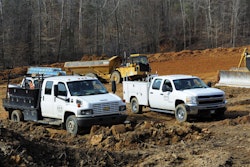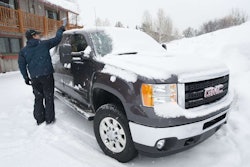Educating your company’s employees on better driving practices is a sure way to improve the corporate bottom line on multiple levels
By Robin Walton
 Training your employees to take care of company vehicles, not only with inspections and proper upkeep, but by the way they drive them, can be a viable method to lower corporate operating costs.
Training your employees to take care of company vehicles, not only with inspections and proper upkeep, but by the way they drive them, can be a viable method to lower corporate operating costs.
With less wear and tear on the vehicles comes lower maintenance costs, and with safer driving habits comes savings in insurance and liability costs.
The biggest return on a driver-training program will be in lowering fuel costs.
A driver training program aimed at cutting costs should include defensive driving skills, vehicle awareness and trailer towing techniques.
GO AHEAD, GET DEFENSIVE
You may already address defensive driving as part of your safety program, but your employee training plan should also include driver training instruction.
Teaching your employees to drive defensively and be more aware of other drivers and risks on the road should end up saving you money in insurance from reduction of accidents and vehicle related incidents.
Make sure that employees aren’t being distracted by their phones and, if work requires phone contacts while driving, that they have hands-free phone calling capabilities to minimize any distractions associated with phone use.
(It can also eliminate traffic citations for texting and improper phone use in many cities and states.)
SAVING FUEL
Teaching your employees fuel-saving techniques can save your company money at the pump and at the shop.
For example, rolling into the throttle slowly will increase fuel economy while reducing wear and tear on the engine, transmission and other drivetrain components of the vehicle.
The same holds true for being aware of the traffic flow, which can reduce the ups and downs of braking and accelerating.
Smooth drivers pay close attention to traffic flow a block ahead and ahead, easing off the gas to let engine compression slow the truck down.
Learning to use a minimum amount of throttle to maintain speed helps reduce fuel consumption, too.
Cruise control helps by preventing too much coasting and having to use extra fuel to get back up to speed.
Stay out of the “tow/haul” mode once the truck is up to cruising speed with a heavy load – and don’t use it when the truck is empty; T/H increases shift rpm points, so the engine is revving higher between shifts, using more fuel.
A careful examination of owner’s manuals points out T/H is designed for use only if the vehicle is shifting a lot (hunting) between gears at a steady speed. Instructions to lock out overdrive are to avoid unneeded strain caused by over shifting.
Instruct employees not to leave their vehicles idling, too. If the weather is hot and they’re using air conditioning, the amount of fuel used may be doubled while the truck sits idling.
Remember, today’s engines don’t use much fuel on restarts, so turn the engine off when the truck is sitting for more than a couple minutes.
Slowing highway speeds saves even more fuel.
Gas mileage decreases rapidly above 55 mph.
In fact, because of aerodynamic drag, pickups drop about 1mpg for every 5mph gain between 55-70mph.
Driving at speeds above 70 mph kills fuel economy at an even more precipitous pace.
Train employees to inspect their company vehicles and to pay attention to changes and warning signs.
VEHICLE CARE
Let’s look at tire awareness as an example.
Tires that are under-inflated can lower gas mileage by 0.3 percent for every 1psi drop.
While newer vehicles have tire pressure monitoring systems, they only activate once tire pressure is 25-percent lower than factory recommended pressure.
At that point you’re already losing a significant amount of fuel mileage.
Properly inflated tires are also safer and will wear more evenly, making them last longer which can end up saving you money as well.
So educate your drivers on paying attention to the tires.
Maintaining proper alignment is another money saver, preventing loss of fuel mileage from extra resistance or drag from improper alignment.
If employees notice the vehicle pulling from side to side or uneven tire wear during their routine vehicle inspections, they need to schedule their vehicle to have the alignment checked.
While proper preventative maintenance for your fleet is probably scheduled, randomly occurring maintenance issues such as a bad oxygen sensor can drastically affect fuel mileage.
Drivers should report a drop in fuel economy or change in the vehicle’s performance.
And don’t overlook carrying around unnecessary cargo and tools as a way to improve fuel economy.
While many times you need a fully loaded pickup to get the job done, you’d be surprised what some of your drivers are dragging around unnecessarily.
Careful planning in terms of material delivery and rarely used tools or parts could net a significant savings in fuel use.
When your employees understand how little changes in their driving habits and their vehicle affect the corporate bottom line (and their paychecks), you should see a little more black ink at the end of the year.
GPS DRIVER MANAGEMENT
GPS Tracking services such as US Fleet Tracking equip you to monitor drivers of your fleet vehicles. An aggressive driving report takes parameters you select – such as a change of 35 mph in less than 10 seconds to detect if drivers are accelerating normally to get onto the interstate or driving dangerously down city streets. You can run a speeding report  that will tell you if a vehicle is going any speed greater than 65 mph (or whatever speed you choose).
that will tell you if a vehicle is going any speed greater than 65 mph (or whatever speed you choose).
About the author: Robin Walton has been a licensed contractor for more than 20 years and has 16 years of financial accounting and systems experience. With a degree in accounting/economics and hands-on construction experience, she understands the day-to-day business of contractors and landscapers.








